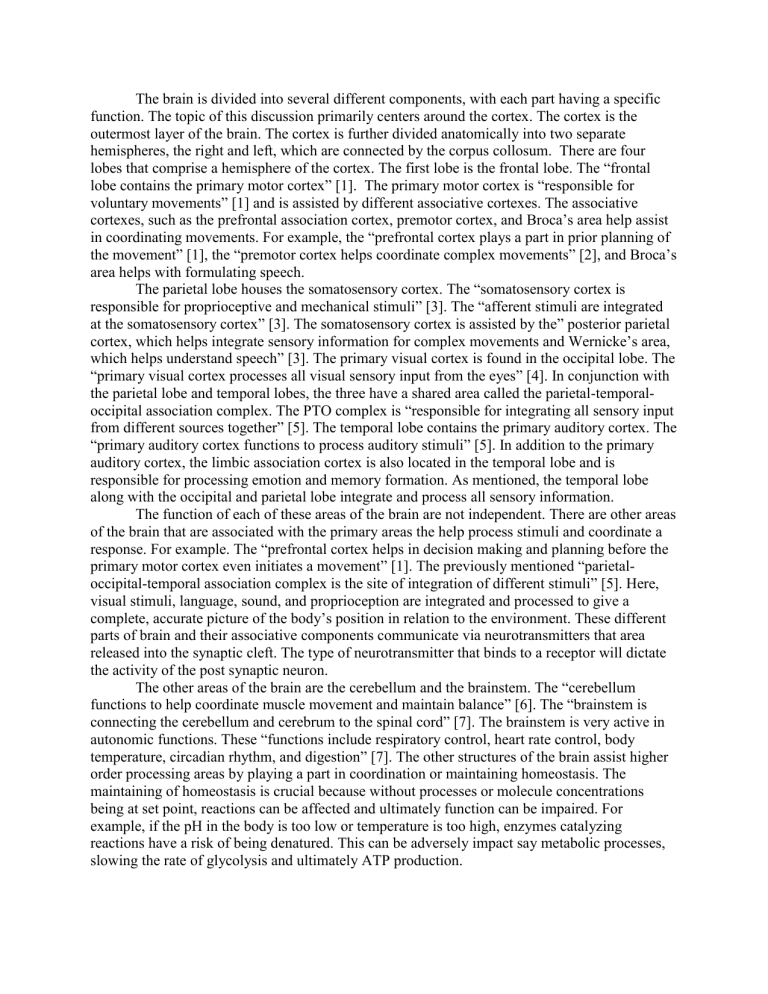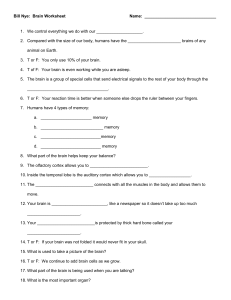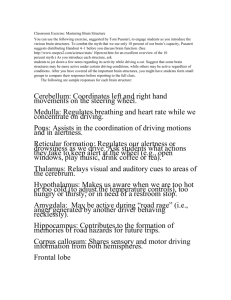
The brain is divided into several different components, with each part having a specific function. The topic of this discussion primarily centers around the cortex. The cortex is the outermost layer of the brain. The cortex is further divided anatomically into two separate hemispheres, the right and left, which are connected by the corpus collosum. There are four lobes that comprise a hemisphere of the cortex. The first lobe is the frontal lobe. The “frontal lobe contains the primary motor cortex” [1]. The primary motor cortex is “responsible for voluntary movements” [1] and is assisted by different associative cortexes. The associative cortexes, such as the prefrontal association cortex, premotor cortex, and Broca’s area help assist in coordinating movements. For example, the “prefrontal cortex plays a part in prior planning of the movement” [1], the “premotor cortex helps coordinate complex movements” [2], and Broca’s area helps with formulating speech. The parietal lobe houses the somatosensory cortex. The “somatosensory cortex is responsible for proprioceptive and mechanical stimuli” [3]. The “afferent stimuli are integrated at the somatosensory cortex” [3]. The somatosensory cortex is assisted by the” posterior parietal cortex, which helps integrate sensory information for complex movements and Wernicke’s area, which helps understand speech” [3]. The primary visual cortex is found in the occipital lobe. The “primary visual cortex processes all visual sensory input from the eyes” [4]. In conjunction with the parietal lobe and temporal lobes, the three have a shared area called the parietal-temporaloccipital association complex. The PTO complex is “responsible for integrating all sensory input from different sources together” [5]. The temporal lobe contains the primary auditory cortex. The “primary auditory cortex functions to process auditory stimuli” [5]. In addition to the primary auditory cortex, the limbic association cortex is also located in the temporal lobe and is responsible for processing emotion and memory formation. As mentioned, the temporal lobe along with the occipital and parietal lobe integrate and process all sensory information. The function of each of these areas of the brain are not independent. There are other areas of the brain that are associated with the primary areas the help process stimuli and coordinate a response. For example. The “prefrontal cortex helps in decision making and planning before the primary motor cortex even initiates a movement” [1]. The previously mentioned “parietaloccipital-temporal association complex is the site of integration of different stimuli” [5]. Here, visual stimuli, language, sound, and proprioception are integrated and processed to give a complete, accurate picture of the body’s position in relation to the environment. These different parts of brain and their associative components communicate via neurotransmitters that area released into the synaptic cleft. The type of neurotransmitter that binds to a receptor will dictate the activity of the post synaptic neuron. The other areas of the brain are the cerebellum and the brainstem. The “cerebellum functions to help coordinate muscle movement and maintain balance” [6]. The “brainstem is connecting the cerebellum and cerebrum to the spinal cord” [7]. The brainstem is very active in autonomic functions. These “functions include respiratory control, heart rate control, body temperature, circadian rhythm, and digestion” [7]. The other structures of the brain assist higher order processing areas by playing a part in coordination or maintaining homeostasis. The maintaining of homeostasis is crucial because without processes or molecule concentrations being at set point, reactions can be affected and ultimately function can be impaired. For example, if the pH in the body is too low or temperature is too high, enzymes catalyzing reactions have a risk of being denatured. This can be adversely impact say metabolic processes, slowing the rate of glycolysis and ultimately ATP production. References: 1. Collins A, Koechlin E. Reasoning, learning, and creativity: frontal lobe function and human decision-making. PLoS Biol. 2012;10(3):e1001293. doi: 10.1371/journal.pbio.1001293. Epub 2012 Mar 27. PMID: 22479152; PMCID: PMC3313946. 2. Purves D, Augustine GJ, Fitzpatrick D, et al., editors. Neuroscience. 2nd edition. Sunderland (MA): Sinauer Associates; 2001. The Premotor Cortex. Available from: https://www.ncbi.nlm.nih.gov/books/NBK10796 3. Raju H, Tadi P. Neuroanatomy, Somatosensory Cortex. [Updated 2021 Nov 14]. In: StatPearls [Internet]. Treasure Island (FL): StatPearls Publishing; 2022 Jan. Available from: https://www.ncbi.nlm.nih.gov/books/NBK555915/ 4. Lamme VA, Supèr H, Landman R, Roelfsema PR, Spekreijse H. The role of primary visual cortex (V1) in visual awareness. Vision Res. 2000;40(10-12):1507-21. doi: 10.1016/s0042-6989(99)00243-6. PMID: 10788655. 5. Jawabri KH, Sharma S. Physiology, Cerebral Cortex Functions. [Updated 2022 Apr 28]. In: StatPearls [Internet]. Treasure Island (FL): StatPearls Publishing; 2022 Jan. Available from: https://www.ncbi.nlm.nih.gov/books/NBK538496/ 6. D'Angelo E. Physiology of the cerebellum. Handb Clin Neurol. 2018;154:85-108. doi: 10.1016/B978-0-444-63956-1.00006-0. PMID: 29903454. 7. Basinger H, Hogg JP. Neuroanatomy, Brainstem. 2022 Jul 6. In: StatPearls [Internet]. Treasure Island (FL): StatPearls Publishing; 2022 Jan–. PMID: 31335017.






